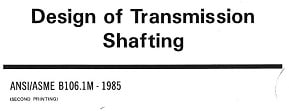SR71-110
Mechanical
- Feb 1, 2023
- 12
Hi All,
I have a shaft attached with this thread. I have couple questions:
1) What would be the best way to control the central axis of the shaft given I have a square end on one side.
2) How to calculate torsion for such a shaft?
3) It's a power transmitting shaft, what would be a good setup for FEA? to apply radial loads?
number Labels on diagram description:
1) Square end with chamfered edges.
2) circular diameters
3) groove
4) fixed pin
Thank you
I have a shaft attached with this thread. I have couple questions:
1) What would be the best way to control the central axis of the shaft given I have a square end on one side.
2) How to calculate torsion for such a shaft?
3) It's a power transmitting shaft, what would be a good setup for FEA? to apply radial loads?
number Labels on diagram description:
1) Square end with chamfered edges.
2) circular diameters
3) groove
4) fixed pin
Thank you

